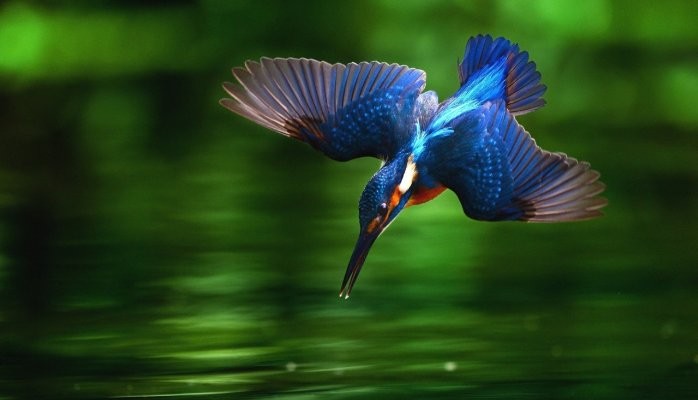
Business Lessons From Nature: Biomimicry
The world is complicated. Each business needs to find some combination of people, information, actions, and technology that allows them to achieve their objectives – and then keep achieving them in a changing world.
This is becoming more difficult for a few reasons: Big Data means that the volume, velocity, and variety of data that any enterprise deals with are all increased. Social media means that customers can voice their opinion unconstrained. Globalisation means more markets and complex supply chains. Better communications & the cloud change the relationship between resources, geography, and ownership. Security and accountability become harder to maintain and more important to demonstrate. Workers and customers are better empowered and demand more.
This situation isn’t going to become simpler, the opposite is true, and it is going to keep changing. Take pretty much any function that your enterprise performs and the challenges of people, information, process, and technology are becoming a more complicated moving target. This is a great opportunity if you solve this quicker and better than your competitors.
Conventional Approach
The conventional way to think about this is as designers, just design a ‘machine’ that’s clever enough and then we’ll solve the problem; we design the business processes, applications, technology, and describe how they interact. Then we create a project to make it happen and put in a bit of governance to keep the machine maintained.
But this doesn’t always work well with business problems
- Complexity: the knowledge is too great to be held in the heads of a few people who understand the challenge and parts of solution.
- Moving Target: the problem and solution elements are both changing.
A Machine is the wrong analogy – machines have no intelligence, they follow instructions defined by a creator and are very poor at adapting to environment change; the one thing we’re sure is going to keep happening.
Belief in the need for a leader, architect, or controlling authority runs very deep in western thought….. But there is another way. There are no leaders in nature and despite this it is fantastically capable of resolving complicated challenges in an optimal way.
Biomimicry
Biomimimicry is the’ conscious emulation of life’s genius’[i]. Nature has had 3.8 million years of research and development. 10 – 30 million well adapted solutions. A 1:1000 survival rate.
As a set of discreet solutions nature has provided inspiration for many real life problems. The beak of a Kingfisher was the template for modifying the nose of the Japanese bullet train resulting in a 15% noise reduction and 10% speed increase. Termite nests are the tallest buildings in the world relative to the size of the maker and they maintain a 1oC variation in temperature whilst the outside varies by 39 oC. Human buildings built on similar principles have used 90% less energy. Self assembling nanotech computer chips by IBM are based on snowflakes and shells. Spiral flow windmills, neural networks, solar technology, capillary biological pumps, self cleaning materials, wing profiles based on whales fins.
Where a machine does poorly, nature creates living systems that are well optimised; self organising, adapting to continual change, innovative, efficient, optimised, resilient, and adaptive. Termites don’t have a design or an architect but their arches still meet in the middle. No ant is in charge but the colony as a whole has an intelligence that allows it to optimise food supply routes.
This is achieved by a set of properties that are common to all living systems.
- Evolution: Winning solutions are replicated, losing solutions are terminated. Mutation means innovation and unexpected solutions. Feedback is used extensively.
- Resource Efficiency: materials are recycled, energy is used efficiently and components are parsimonious.
- Adaptable to Change: Self renewal. Resilience is created by decentralisation, redundancy, and diversity.
- Development & Growth: Design is component based with nested hierarchies, it is bottom-up and components are self organising.
Summary and Next?
So, things are challenging, our current paradigm of top down design led solutions don’t work that well, but nature resolves similar problems with flair.... So how do we apply this to Business Consulting? I’ll share some ideas on this in my next blog entry....[ii]
[i] Defined by Janine Benyus
[ii] This paper is inspired by the work of Biomimicry 3.8. Material on the practical approach is taken directly from Biomimicry 3.8 under a Common Creativity licence. http://biomimicry.net/
Data Engineering Lead - Enabling units at AstraZeneca
8yNice article - we can learn a lot from nature. One of the most forward thinking people of the 20th century was Buckminster Fuller - a 1972 paper by the Buckminster Fuller institute covers remarkably similar ground - just shows how forward thinking Mr Fuller was ! http://www.bfi.org/sites/default/files/attachments/dymax-forum/Tapping-into-Nature-2015e.pdf
Director, Life Sciences Architecture @ PMI
8yThanks George, really glad you liked it, it's a wonderful topic and it gives me ideas to lots of problems.... Next blog coming up in about a week I'd say